
* In the late 1950s, the Beech Aircraft Corporation developed a twin-piston business aircraft, the "Beech Queen Air", which was derived from the earlier Beech Twin Bonanza. The Queen Air would lead to the "King Air" turboprop twin, which in turn led to the refined "Super King Air", which would prove popular aircraft. Along the line, they also led to a series of small airliners, including the "Swearingen Metro", the "Beech Model 99", and the "Beech Model 1900", which were all built in numbers. This document provides a history and description of the Swearingen Metro, Beech 99, and Beech 1900 -- plus the "Swearingen Merlin", the Metro's business aircraft predecessor. A list of illustration credits is given at the end.
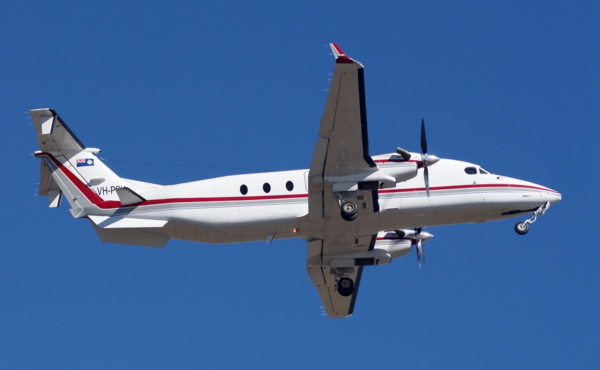
* Ed Swearingen of San Antonio, Texas, got his start in aircraft manufacture in the early 1960s by jazzing up Beech Twin Bonanza and Queen Air twin-piston aircraft, naming his updates the "Excalibur". Becoming more ambitious, Swearingen then designed his own piston twin, mating a new pressurized fuselage to Queen Air wings, naming the machine the "SA26 Merlin I" -- named after the swift merlin falcon, not the sorcerer. It was originally powered by twin Lycoming TIGO-540 flat-six air-cooled engines with 300 kW (400 HP) each.
The Merlin I would never go beyond prototype phase. Swearingen had contemplated building a family of aircraft, all with the same fuselage, but with piston, turboprop, or jet propulsion. The three different configurations wouldn't happen in practice; during prototype evaluation, Swearingen decided it would be better to focus on turboprop propulsion, fitting Pratt & Whitney Canada (PWC) PT6A-20 turboprops with 430 kW (580 SHP) each, his intent being to take on the Beech King Air. The result, the "SA26-T Merlin II", performed its first flight on 13 April 1965, with certification following, and 36 production "Merlin IIA" machines built.
The engines were then updated to Garrett AiResearch TPE331-1-151G turboprops, with 495 kW (665 SHP) each, resulting in 1968 in the "SA26-T Merlin IIB". The Merlin IIB makes a good baseline for the Merlin series. It was hard to tell externally from the Merlin IIA, both being all-metal, low-wing aircraft with twin engines and tricycle landing gear. The wing had two spars and was straight, with a dihedral of 7 degrees, plus ailerons and slotted flaps; the tailfin was swept, with a prominent forward fin fillet, and the tailplane was swept as well, with a dihedral of 7 degrees. Flight controls were manually actuated, except for electrically-operated flaps. All flight surfaces had pneumatic de-icing boots, while the engine intakes were de-iced by hot engine bleed air.
The TPE331 engines drove three-bladed, reversible Hartzell propellers. The engine intakes featured hot-air de-icing, and there was a "synchrophaser" system to keep the two props in proper beat. The increase in power relative to the PWC engines meant a distinct improvement in performance all around. There were fuel tanks in the wings, with a total capacity of 2,456 liters (648 US gallons), and a refueling point in each wing. All landing gear had single wheels and electrically retracted forward, with the main gear being stowed in the engine nacelles.
___________________________________________________________________
SWEARINGEN MERLIN IIB:
___________________________________________________________________
wingspan:
13.98 meters (45 feet 10 inches)
wing area:
25.97 sq_meters (279.7 sq_feet)
length:
12.22 meters (40 feet 1 inch)
height:
4.37 meters (14 feet 4 inches)
empty weight:
2,925 kilograms (6,450 pounds)
MTO weight:
4,535 kilograms (10,000 pounds)
cruise speed:
475 KPH (295 MPH / 255 KT)
service ceiling:
9,100 meters (29,900 feet)
max range:
2,870 kilometers (1,785 MI / 1,550 NMI)
___________________________________________________________________
There were two aircrew, with a cockpit door to the passenger compartment. Avionics were conventional for the era, with variations as per customer request; the windscreen was electrically de-iced. Six passenger seats were standard, with the front pair facing backwards; a high-density eight-seat configuration was also available. There was a toilet and baggage hold in the rear, with a beverage bar as standard.
There were three windows on each side of the fuselage; there are photos of the Merlin IIA with two windows on the left side of the fuselage, but that may have not been a production feature. There was a downward-hinging airstair door on the left rear fuselage -- it had a locking scheme to act as a structural reinforcement for the fuselage -- and an emergency exit on the right. Accommodations were pressurized and climate conditioned. A total of 87 Merlin IIBs was built.
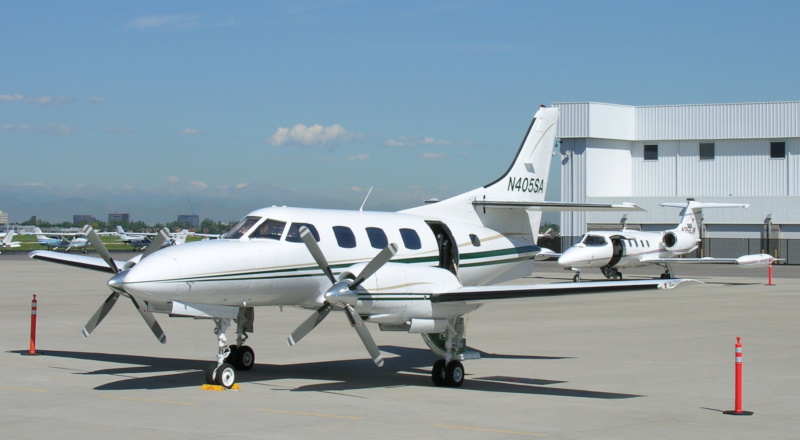
* Following the Merlin II, Swearingen introduced the "SA226-T Merlin III", which featured:
The modifications were inherited from the stretched Swearingen Metro, discussed below. With all the changes, the Merlin III looked substantially less like a Queen Air, and was effectively a purely Swearingen design. The Merlin III was certificated in 1970, going into service in 1973.
After production of 50 Merlin IIIs, in 1975 Swearingen introduced the "Merlin IIIA", which featured:
43 Merlin IIIAs were sold. The next version was, of course, the "Merlin IIB", the primary change being TPE-331-10 turboprops, driving four-blade propellers, with 670 kW (900 SHP). It also had an improved electrical system. 73 were built, making it the most prolific short-body Merlin variant.
The Merlin IIIB was followed in 1982 by the "Merlin IIIC", which was externally identical, the fundamental change being a higher gross weight. 31 were sold; it was followed in turn in 1984 by the "Merlin 300" -- which was the same, except with winglets. Little testing was done to see how much effect the winglets had, and they may have been essentially cosmetic.
Only ten Merlin 300s were sold to end of production of the "short" Merlin series in 1986, after only ten deliveries. That gave Merlin production as:
* The Merlin was the basis for a more successful series of aircraft. In the late Sixties, Swearingen decided to stretch the Merlin to accommodate 19 seats, that being the biggest size of airliner that could be flown without flight attendants. The prototype of the resulting "SA226-TC Metro" -- later referred to as the "Metro I", reflecting later variants -- took to the air for the first time on 26 August 1969.
At that point, Swearingen ran into financial difficulties due to the global recession that began in 1970, with Fairchild then buying up a 90% interest in the firm, which was renamed the Swearingen Aircraft Corporation. Fairchild had been building the wings for the Merlin III / Metro I, and had a number of wings that hadn't been delivered or paid for; Fairchild officials decided that buying out Swearingen was the best way to recoup costs. Ed Swearingen remained as chairman of the board, but a new team was brought by Fairchild. The new management canceled work on a turbofan-powered version of the Merlin.
The Metro I was certified in 1970, with introduction to service in 1973. Anyone familiar with aircraft would recognize that the Metro I was essentially a Merlin III with a longer fuselage. The Metro I was really just a stretched Merlin III -- though being parallel designs, it could just as well be said that the Merlin III was a cut-down version of the Metro I.

The powerplants were Garrett AiResearch TPE331-3UW-303G turboprops with 700 kW (940 SHP) each, driving three-bladed reversible Hartzell props with electrical de-icing. Cockpit arrangement and avionics were generally similar to that of the Merlin II, though the cockpit was separated from the passenger compartment by a curtain, not a door. It also had oval windows, not the rounded-rectangular windows of the Merlin.
Along with the two aircrew, there was standard seating for 19 to 20 passengers. The seats could be easily folded away to obtain space for cargo, with a moveable bulkhead partitioning the forward passenger and rear cargo spaces. The door arrangement was considerably revised from that of the Merlin II, with the Metro II featuring an airstair door on the front left fuselage; a large upward-opening cargo door on the left rear fuselage; emergency exits over each wing, one on the left and two on the right.; and a baggage compartment in the nose, with the door on the left. Of course, accommodations were pressurized and climate-conditioned.
The quick-change interior could be easily adapted to medical airlift, with up to ten litters, or photo-surveying, with twin cameras. A dedicated cargo version, without passenger windows and with an incrementally bigger cargo load, was offered; as was an executive version, eventually designated the "SA-266AT Merlin IV", featuring from 12 to 15 seats.
In 1974, the original Metro I was replaced by the "SA226-TC Metro II", which was the Metro I with the updates of the Merlin IIIA; the executive aircraft equivalent was the "Merlin IVA". It had larger rectangular windows, and provision for a booster rocket in the tail to facilitate take-offs under "hot and high" conditions.
In 1980, Swearingen introduced the "Metro IIA", which had TP331-10 engines with more power, and MTO raised to 5,940 kilograms (13,100 pounds). A total of 198 Metro I and Metro II airliners was built in all, along with 56 Merlin IVAs.
___________________________________________________________________
SWEARINGIN SA226-TC METRO II:
___________________________________________________________________
wingspan:
14.1 meters (46 feet 3 inches)
wing area:
25.78 sq_meters (277.5 sq_feet)
length:
18.1 meters (59 feet 5 inches)
height:
5.12 meters (16 feet 10 inches)
empty weight:
3,379 kilograms (7,450 pounds)
MTO weight:
5,670 kilograms (12,500 pounds)
max cruise speed:
473 KPH (294 MPH / 255 KT)
service ceiling:
8,230 meters (27,000 feet)
range:
1,100 kilometers (685 MI / 595 NMI)
___________________________________________________________________
* The "SA227-AC Metro III" was introduced in 1981, this model featuring wingspan stretched by 3.05 meters (10 feet); four-bladed McCauley props; "quick-access" engine cowlings; and various aerodynamic improvements, including landing gear doors that re-closed after the gear was extended. The Metro III was introduced with an MTO of 6,350 kilograms (14,000 pounds), later increased to 6,575 kilograms (14,500 pounds), with an option for an MTO of 7,255 kilograms (16,000 pounds) -- the later production machines being designated "SA227-BC". 291 Metro IIIs were built in all.
A VIP / executive version was offered as the "Merlin IVC"; while a cargo hauler variant with no windows, reinforced flooring, and cargo-handling kit was sold as the "Expediter". The Merlin IVC and Expediter were both designated the "SA227-AT", with 43 sold. In the late 1980s, in response to reliability problems with the Garrett engines, a "Metro IIIA" was offered with two Pratt & Whitney Canada PT6A-45R turboprops, but none were sold.
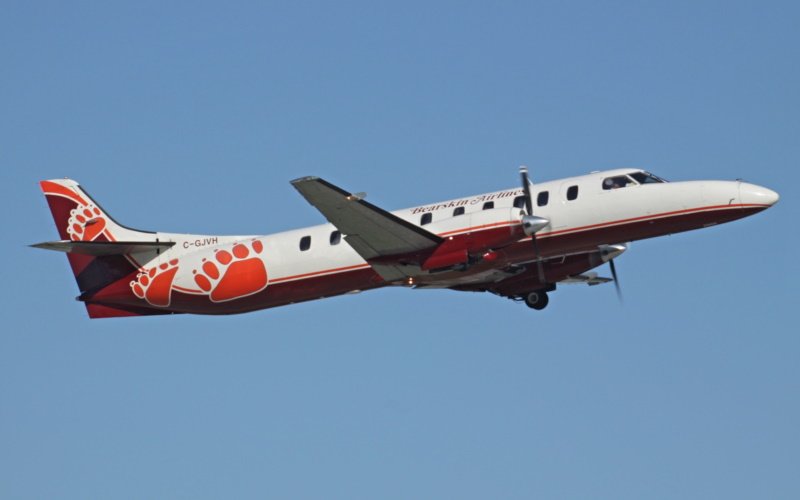
The final production model was the "SA227-CC" and "SA227-DC", both known as the "Metro 23", originally the "Metro IV", which featured further uprated engines and still higher MTO -- the SA227-CC, with TPE331-11U engines, was only built in small quantities. A "Metro 23EF" with a belly pannier for more baggage was also introduced, as was a "Merlin 23" VIP / executive variant, and an "Expediter 23" cargo hauler. A total of 115 Metro 23s in all subvariants was built, for total production of 198 + 56 + 291 + 43 + 115 == 703 Metros and all.
There was talk of a "Metro 25" with a tee tail and other improvements; in the late 1990s, Fairchild investigated a Metro with a raised roof for more headroom. None of it happened before the company went broke in 2003. The Metro still lingers in service.
BACK_TO_TOP* A number of foreign military services obtained the Metro for utility use, but it wasn't until 1988 that the US military decided to obtain the type, giving it the designation of "C-26". The US Air National Guard (Air NG) initially obtained 10 SA227-AC Metro IIIs as the "C-26A". They had a "quick change" interior, being easily converted from passenger to medevac or cargo configuration. Three SA227-BC Metro IIIs were then obtained, also as C-26As, with one to the Air NG and two to the Army NG.
37 Metro 23s were finally obtained as "C-26Bs", with 28 to the Air NG and 9 to the Army NG. That gave total acquisition of 50 new-build Metros by the Air and Army NG. 11 C-26Bs were later updated to "C-26E" spec, with a Rockwell Collins Electronic Flight Instrument System.

The Air NG operated a dozen of their C-26s on the "counter-drug" mission, in support of US Customs, the US Coast Guard, and other government agencies, with some deployments to Iraq and Afghanistan. The dozen included 11 C-26Bs upgraded to "RC-26B Condor" spec, plus a single used Merlin IVA converted to "UC-26C" spec. The payload fits on these machines -- indeed, on the dog's breakfast of all Metro special-mission aircraft -- are confusing. There were multiple configurations:
In 1996, a number of surplus C-26s were passed on to US allies, including four to Colombia, four to Mexico, four to Peru, and two to Venezuela. They were mostly C-26As, at least some of them converted to RC-26 specification. It seems all four Mexican machines were RC-26As, featuring the typical litter of blade antennas for an RC-26, plus an imaging turret forward under the belly; with a small dome behind the wing, possibly for a radio direction finder; and a large radome on the rear.
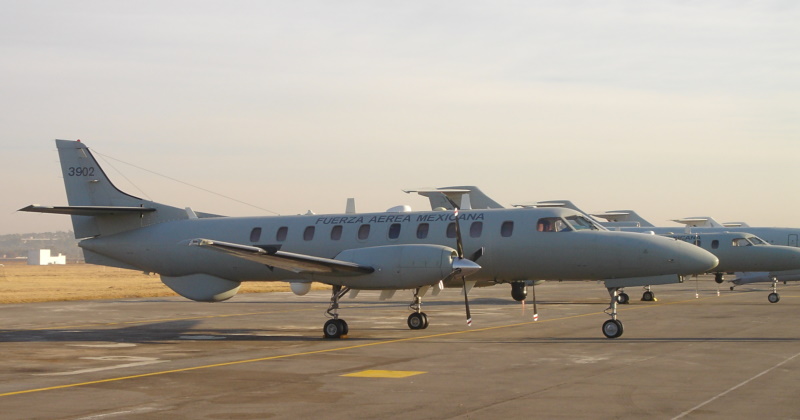
Seven of the US Air Force C-26Bs were passed on to the US Navy in 1998 -- four ending up in utility use as "C-26D" machines, plus two "RC-26D" and one "EC-26D" for range support operations. The Navy C-26s apparently had some avionics improvements; photos of the RC-26Ds showed them with a litter of antennas, but no visible imager turret, while photos of the EC-26D showed it to have a radar under the rear fuselage, along with a litter of antennas.
The last ANG RC-26Bs, 11 aircraft, were retired in 2022. They had been flying to spot drug smugglers up to their retirement. They were also occasionally used to monitor mass protests, particularly in the widespread unrest of 2020. However, it appears many of the C-26s are still in service. Indeed, in 2018 the US Naval Test Pilot School accepted a C-26A converted to the "Airborne Systems Training And Research Support (ASTARS III)" configuration. It was configured as a "flying classroom", with:
This machine was actually one of the four obtained by Mexico, having been handed back to the USA. Sources hint there have been further transfers of aircraft, including sales to civil users, but details are unclear. The Swedish Air Force also operated one Metro III as a prototype airborne early warning aircraft, carrying an Ericsson PS-890 active array radar in a beam antenna fairing perched above its back.
BACK_TO_TOP* In the early 1960s, the Beechcraft Corporation became interested in the commuter airliner market, leading to the startup of a development program in 1965. The resulting prototype of the "Model 99 Airliner" performed its initial flight in July 1966, with the first production aircraft delivered on 2 May 1968.
The Model 99 Airliner was derived from the earlier Beechcraft Queen Air and King Air -- a somewhat confusing lineage, since the King Air was a derivative of the Queen Air as well. The Model 99 featured the wings of the Queen Air, the engines and nacelles from the King Air, along with various subsystems from both types. The nose was entirely new.
The Model 99 Airliner was powered by twin PWC PT6A-20 turboprops with 410 kW (550 HP) each, driving Hartzell three-bladed reversible props. The nose gear had one wheel and retracted backwards; the main gear had twin wheels and retracted forward into the engine nacelles. It could carry up to fifteen passengers along with the two crew. There was a passenger door on the left rear of the fuselage and emergency exits on each side over the wings; baggage could be carried in the nose, with doors on each side of the nose for stowage.
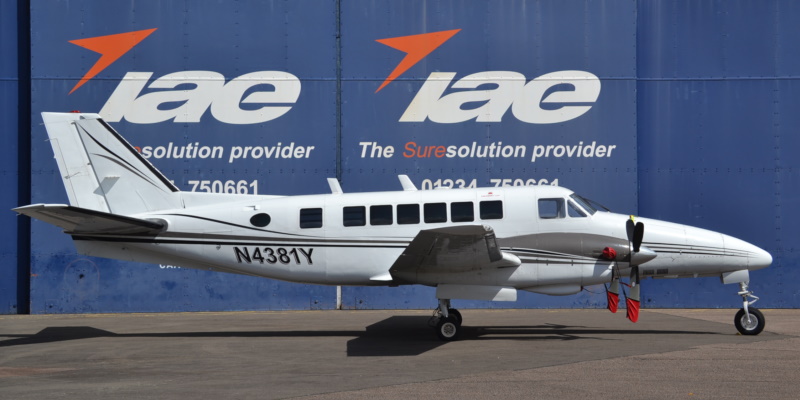
The Model 99 Airliner was available in combination passenger-freight or "combi" configuration, with a large cargo door just forward of the passenger door, removeable seats, and a bulkhead that could be moved forward or back to change the partition of passengers and freight. Beech also offered a "Model 99 Executive" version that could be ordered with a range of interior fits as per customer requirement.
* Production later moved on to the "Model A99", which was much the same as the original Model 99, but featured more powerful PT6A-27 engines providing 510 kW (680 SHP) each. It was only available in Airliner configuration. It was followed by a "B99", which had the same engines, but featured a suite of other improvements. It was available in both Airliner and Executive configurations. A prototype of an "A99A", which deleted the wing center section fuel tanks, was built, but didn't go into manufacture.
___________________________________________________________________
BEECH MODEL B99 AIRLINER:
___________________________________________________________________
wingspan:
14 meters (45 feet 10 inches)
wing area:
26 sq_meters (279.7 sq_feet)
length:
13.58 meters (44 feet 7 inches)
height:
4.38 meters (14 feet 4 inches)
empty weight:
2,607 kilograms (5,749 pounds)
MTO weight:
4,717 kilograms (10,400 pounds)
max cruise speed:
457 KPH (284 MPH / 247 KT)
service ceiling:
7,985 meters (26,200 feet)
range:
1,415 kilometers (880 MI / 765 NMI)
___________________________________________________________________
The Model 99 series was never a big seller, and so production was ended in late 1976 after delivery of 164 machines, mostly to US operators. Beech management quickly had misgivings about getting out of the commuter airliner market, and initiated programs to come up with product offerings. One of the programs was to revive the Model 99. A Model B99 was repurchased from Allegheny Airlines and completely refurbished, the main change being fit of still more powerful PT6A-36 turboprops with 535 kW (715 SHP) each, with an accompanying increase in maximum take-off weight.
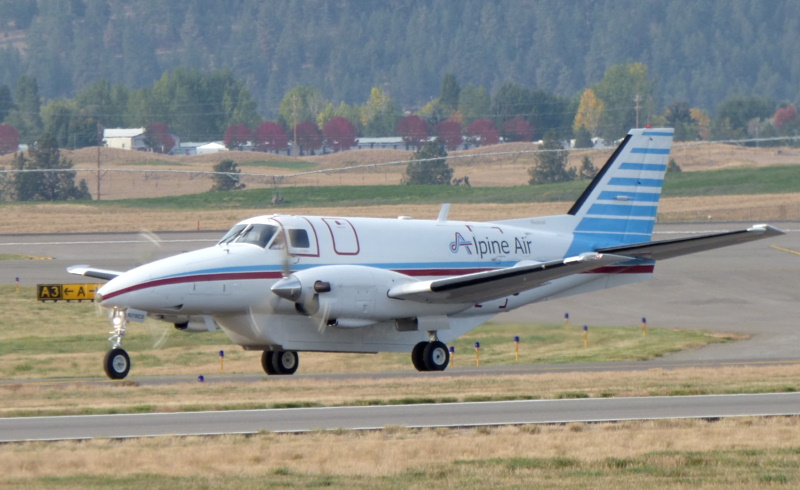
Initial flight of the updated machine, designated the "Model C99", was on 20 June 1980, with production beginning in September and initial deliveries in the summer of 1981. Only 76 were delivered up to end of production in 1986, for total production of 240 Model 99s. A few were operated as VIP transports by the military services of Chile, Peru, and Thailand. Beech 99s linger in service, primarily in the freighter role, sometimes being fitted with belly freight panniers.
BACK_TO_TOP* Beech initiated two other programs to re-enter the commuter airliner market. The first, the "Model 1300 Commuter", was nothing more than a variant of the Beech Super King Air turbo twin. It was only built in small quantities.
The second, the "Model 1900 Airliner", was more ambitious, though it also was based on the Super King Air, stretched to accommodate 19 passengers, in a pressurized and climate-conditioned environment. Work on three flight prototypes and a ground-test airframe began in 1981, with the initial flight of the first prototype on 3 September 1982, the second following on 30 November. Certifications were awarded a year later, with initial deliveries to customers in early 1984. It appears the Model C99 was introduced into production as a stopgap until the better Model 1900 was available.
The Model 1900 was built primarily of aircraft aluminum alloy. It was intended to operate from shorter runways and in all weather conditions, with the ability to fly from grass or other unimproved runways. It was flown with pilot and copilot for airliner service, but could be flown with a single pilot for corporate or cargo operations. Cockpit controls were generally like those of the Super King Air. It clearly looked like a Super King Air, with the same arrangement and same fuselage diameter, but it was stretched by 4.27 meters (14 feet) and was fitted with more powerful PWC PT6A-65B turboprops offering 820 kW (1,100 SHP) take-off power, driving Hartzell four-bladed reversible props of composite construction. The uprated engines were originally evaluated on a Super King Air for trials.
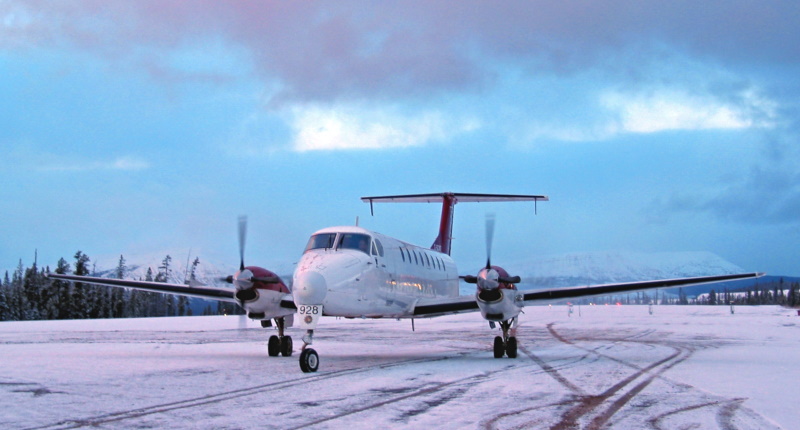
The straight wings were low-mounted; the tail was in tee configuration, with a slightly swept tailplane, and a more strongly swept tailfin, with a large forward fillet. Flight controls were conventional, with single slotted flaps; ailerons; elevators; rudder; and trim tabs in the elevators, rudder, and left aileron.
The Model 1900 differed from the Super King Air significantly in being fitted with small fixed tailplanes or "stabilons" on the rear of the fuselage in addition to the normal tee tailplane, presumably to correct for pitch instability. The Model 1900 also added a small vertical fin called a "taillet" to the bottom of each end of the tee tailplane. The first 74 Model 1900Cs had bladder fuel tanks in the wings, but the later production "Model 1900C-1" featured "wet" wings, with integral fuel tanks that significantly stretched range compared to the Super King Air. The Model 1900C and 1900C-1 were effectively identical externally.
The passenger liner version of the Model 1900 was designated the "Model 1900C", and featured 19 passenger seats in two rows; an airstair door on the forward left fuselage; a single emergency exit over the left wing, two emergency exits over the right wing; and an upward-hinging cargo door on the rear left fuselage. Incidentally, the three Model 1900 prototypes had airstair doors forward and back, but that was judged to be overkill.
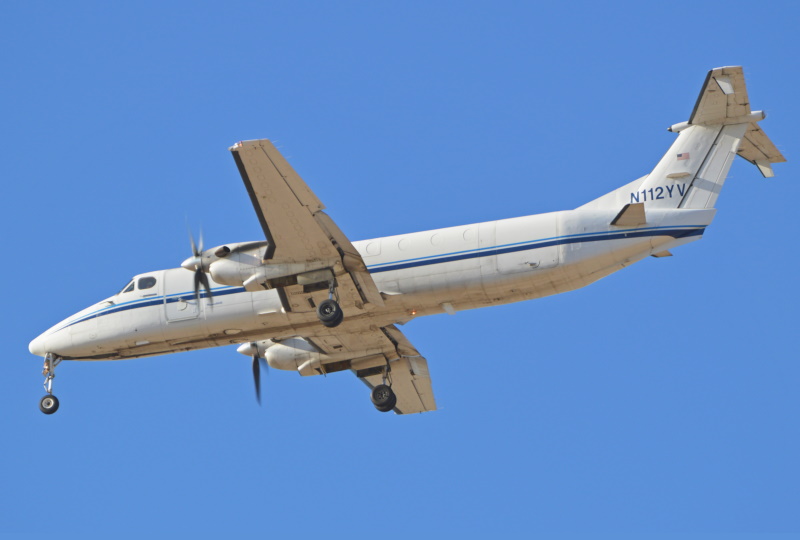
A lavatory in the rear was optional. A half dozen Model 1900Cs were obtained by the US Air National Guard as the "C-12J". Eight were sold to Egypt, four being in a SIGINT configuration, two in a maritime patrol configuration -- the maritime patrol machines featuring Litton search radar; a Motorola side-looking multimode radar; and Singer S-3075 ESM to spot and locate radio emitters. Taiwan's military also obtained the Model 1900C.
An executive transport version of the Model 1900 was sold in parallel as the "Model 1900 Exec-Liner", with initial deliveries in 1985. It was generally similar to the Model 1900C, but had a second passenger door in place of the cargo door, and could have accommodations for 12 to 18 passengers as per customer specification.
* A total of 248 Model 1900C / Exec-Liner machines was sold up to 1991, when the variant was replaced on the production line by the "Model 1900D". It was distinctly different in appearance from the first generation Model 1900s, with a raised fuselage to give passenger stand-up headroom, plus winglets and twin ventral fins instead of the single ventral fin of the Super King Air / Model 1900C.
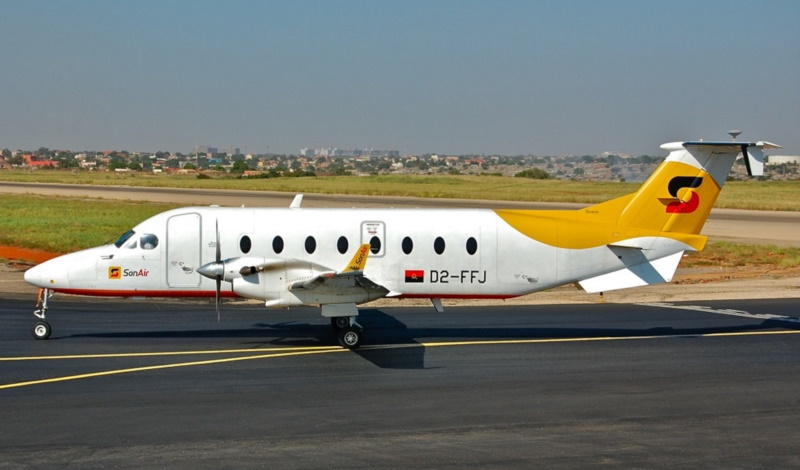
The Model 1900D was fitted with more powerful PT6A-67D turboprops with 955 kW (1,280 SHP), and featured a cockpit Rockwell Collins EFIS-84 Electronic Flight Instrument System.
___________________________________________________________________
BEECH MODEL 1900D AIRLINER:
___________________________________________________________________
wingspan:
17.64 feet (57 feet 9 inches)
wing area:
28.8 sq_meters (303 sq_feet)
length:
17.62 meters (57 feet 8 inches)
height:
4.72 meters (15 feet 5 inches)
empty weight:
4,732 kilograms (10,434 pounds)
MTO weight:
7,764 kilograms (17,120 pounds)
cruise speed:
520 KPH (320 MPH / 280 KT)
service ceiling:
7,620 meters (25,000 feet)
loaded range:
705 kilometers (440 MI / X 380)
___________________________________________________________________
Sales were brisk; an executive version was sold as well. However, the market moved towards regional jets, and so Model 1900 production was ended in 2002. 439 Model 1900Ds were built, for a total of 687 Model 1900s produced in all. The Model 1900 saw government / military service with Algeria, Australia, Bolivia, Egypt, Myanmar, Taiwan, South Sudan Switzerland, Thailand, the United Arab Emirates -- as well as the US Air Force & Army. It continues in service in declining numbers.
BACK_TO_TOP* This document began life as notes rendered down from the online Wikipedia, then using my set of JANE'S ALL THE WORLD'S AIRCRAFT volumes to flesh it out. Other sources included:
* Illustrations credits:
* Revision history:
v1.0.0 / 01 jun 17 v1.0.1 / 01 may 19 / Review, update, & polish. v1.0.2 / 01 apr 21 / Illustrations update. v1.1.0 / 01 feb 23 / Formatting update. v1.1.1 / 01 feb 25 / Review & polish. (+)BACK_TO_TOP
